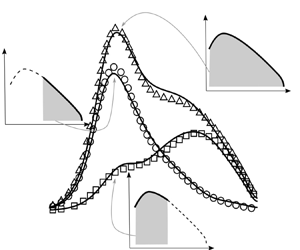No CrossRef data available.
Published online by Cambridge University Press: 28 November 2024

Reynolds-averaged models for solving the Navier–Stokes equations are implicitly based on Kolmogorov's theory for describing energy transfers between the different turbulent scales, which means that all the energy produced at large scales is transferred at a constant rate to the smallest turbulent scales where it is dissipated. As a result, these models use a single scale to describe the turbulence spectrum, which in cases of non-equilibrium turbulence does not provide an adequate description of the transfers actually observed. This is particularly the case for wall-bounded flows at high Reynolds numbers, such as turbulent channel flows. Taking up an approach developed by Schiestel (2007 Modeling and Simulation of Turbulent Flows, ISTE Ltd and John Wiley & Sons), which aims to define a Reynolds-averaged Navier–Stokes model transporting several scales of turbulence, a two-scale Reynolds stress model (RSM) was developed in order to take into account the interactions between the inner and outer regions of wall-bounded flows. The results obtained with the model are compared with the direct numerical simulations (DNS) of Lee & Moser (J. Fluid Mech., vol. 860, 2019, pp. 886–938) in a turbulent channel for several friction Reynolds numbers up to  $Re_{\tau }=5200$, for which partial integrations in spectral space were carried out, highlighting distinct behaviours between small and large scales of turbulence. The model developed provides an accurate description of the contributions at small and large scales and thus reproduces the high-Reynolds-number effects observed in DNS data. In addition, comparisons with the DNS data served to validate a large part of the closure relations used for the various terms in the two-scale RSM.
$Re_{\tau }=5200$, for which partial integrations in spectral space were carried out, highlighting distinct behaviours between small and large scales of turbulence. The model developed provides an accurate description of the contributions at small and large scales and thus reproduces the high-Reynolds-number effects observed in DNS data. In addition, comparisons with the DNS data served to validate a large part of the closure relations used for the various terms in the two-scale RSM.